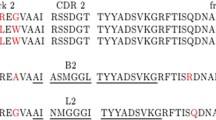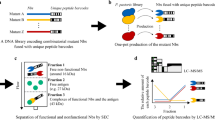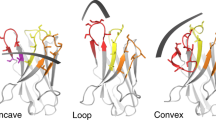Abstract
Nanobodies are special derivatives of antibodies, which consist of single domain fragments. They have become of considerable interest as next-generation biotechnological tools for antigen recognition. They can be easily engineered due to their high stability and compact size. Nanobodies have three complementarity-determining regions, CDRs, which are enlarged to provide a similar binding surface to that of human immunoglobulins. Here, we propose a benchmark testing algorithm that uses 3D structures of already existing protein-nanobody complexes as initial structures followed by successive mutations on the CDR domains. The aim is to find optimum binding amino acids for hypervariable residues of CDRs. We use molecular dynamics simulations to compare the binding energies of the resulting complexes with that of the known complex and accept those that are improved by mutations. We use the MDM4-VH9 complex, (PDB id 2VYR), fructose-bisphosphate aldolase from Trypanosoma congolense (PDB id 5O0W) and human lysozyme (PDB id 4I0C) as benchmark complexes. By using this algorithm, better binding nanobodies can be generated in a short amount of time. We suggest that this method can complement existing immune and synthetic library-based methods, without a need for extensive experimentation or large libraries.











Similar content being viewed by others
References
Alberts, B., Johnson, A., Lewis, J., Raff, M., Roberts, K., Walter, P.: B cells and antibodies. In: Molecular biology of the cell. 4th edition. Garland Science, (2002)
Kremer, L., Garcia-Sanz, J.A.: Is the recent burst of therapeutic anti-tumor antibodies the tip of an iceberg? Front. Immunol. 9, 442 (2018)
Drabek, D., Janssens, R., de Boer, E., Rademaker, R., Kloess, J., Skehel, J., Grosveld, F.: Expression cloning and production of human heavy-chain-only antibodies from murine transgenic plasma cells. Front. Immunol. 7, 619 (2016)
Tiller, K.E., Tessier, P.M.: Advances in antibody design. Annu. Rev. Biomed. Eng. 17, 191–216 (2015). https://doi.org/10.1146/annurev-bioeng-071114-040733
Trevino, S.R., Scholtz, J.M., Pace, C.N.: Amino acid contribution to protein solubility: Asp, Glu, and Ser contribute more favorably than the other hydrophilic amino acids in RNase Sa. J. Mol. Biol. 366(2), 449–460 (2007)
McMahon, C., Baier, A.S., Pascolutti, R., Wegrecki, M., Zheng, S., Ong, J.X., Erlandson, S.C., Hilger, D., Rasmussen, S.G.F., Ring, A.M., Manglik, A., Kruse, A.C.: Yeast surface display platform for rapid discovery of conformationally selective nanobodies. Nat. Struct. Mol. Biol. 25(3), 289–296 (2018). https://doi.org/10.1038/s41594-018-0028-6
Norman, R.A., Ambrosetti, F., Bonvin, A.M., Colwell, L.J., Kelm, S., Kumar, S., Krawczyk, K.: Computational approaches to therapeutic antibody design: established methods and emerging trends. Brief. Bioinform. (2019)
Uchański, T., Zögg, T., Yin, J., Yuan, D., Wohlkönig, A., Fischer, B., Rosenbaum, D.M., Kobilka, B.K., Pardon, E., Steyaert, J.: An improved yeast surface display platform for the screening of nanobody immune libraries. Sci. Rep. 9(1), 382 (2019)
Hassanzadeh-Ghassabeh, G., Devoogdt, N., De Pauw, P., Vincke, C., Muyldermans, S.: Nanobodies and their potential applications. Nanomedicine 8(6), 1013–1026 (2013)
Pierce, B.G., Wiehe, K., Hwang, H., Kim, B.-H., Vreven, T., Weng, Z.: ZDOCK server: interactive docking prediction of protein–protein complexes and symmetric multimers. Bioinformatics 30(12), 1771–1773 (2014)
Kozakov, D., Hall, D.R., Xia, B., Porter, K.A., Padhorny, D., Yueh, C., Beglov, D., Vajda, S.: The ClusPro web server for protein–protein docking. Nat. Protoc. 12(2), 255 (2017)
Lefranc, M.P.: IMGT unique numbering for the variable (V), constant (C), and groove (G) domains of IG, TR, MH, IgSF, and MhSF. Cold Spring Harb. Protoc. 2011(6), 633–642 (2011). https://doi.org/10.1101/pdb.ip85
Bannas, P., Hambach, J., Koch-Nolte, F.: Nanobodies and nanobody-based human heavy chain antibodies as antitumor therapeutics. Front. Immunol. 8, 1603 (2017)
Muyldermans, S.: Nanobodies: natural single-domain antibodies. Annu. Rev. Biochem. 82, 775–797 (2013)
Li, T., Pantazes, R.J., Maranas, C.D.: OptMAVEn–a new framework for the de novo design of antibody variable region models targeting specific antigen epitopes. PLoS One 9(8), e105954 (2014)
Barderas, R., Desmet, J., Timmerman, P., Meloen, R., Casal, J.I.: Affinity maturation of antibodies assisted by in silico modeling. Proc. Natl. Acad. Sci. U.S.A. 105(26), 9029–9034 (2008)
Mahajan, S.P., Meksiriporn, B., Waraho-Zhmayev, D., Weyant, K.B., Kocer, I., Butler, D.C., Messer, A., Escobedo, F.A., DeLisa, M.P.: Computational affinity maturation of camelid single-domain intrabodies against the nonamyloid component of alpha-synuclein. Sci. Rep. 8(1), 17611 (2018)
Zuo, J., Li, J., Zhang, R., Xu, L., Chen, H., Jia, X., Su, Z., Zhao, L., Huang, X., Xie, W.: Institute collection and analysis of nanobodies (iCAN): a comprehensive database and analysis platform for nanobodies. BMC Genomics 18(1), 797 (2017)
Wilton, E.E., Opyr, M.P., Kailasam, S., Kothe, R.F., Wieden, H.-J.: sdAb-DB: the single domain antibody database. ACS Synth. Biol. 7(11), 2480–2484 (2018). https://doi.org/10.1021/acssynbio.8b00407
Katoh, K., Standley, D.M.: MAFFT multiple sequence alignment software version 7: improvements in performance and usability. Mol. Biol. Evol. 30(4), 772–780 (2013)
Lassmann, T., Frings, O., Sonnhammer, E.L.: Kalign2: high-performance multiple alignment of protein and nucleotide sequences allowing external features. Nucleic Acids Res. 37(3), 858–865 (2008)
Notredame, C., Higgins, D.G., Heringa, J.: T-coffee: a novel method for fast and accurate multiple sequence alignment. J. Mol. Biol. 302(1), 205–217 (2000)
Sievers, F., Wilm, A., Dineen, D., Gibson, T.J., Karplus, K., Li, W., Lopez, R., McWilliam, H., Remmert, M., Söding, J.: Fast, scalable generation of high-quality protein multiple sequence alignments using Clustal Omega. Mol. Syst. Biol. 7(1) (2011).
Okonechnikov, K., Golosova, O., Fursov, M., Team, U.: Unipro UGENE: a unified bioinformatics toolkit. Bioinformatics 28(8), 1166–1167 (2012)
Waterhouse, A.M., Procter, J.B., Martin, D.M., Clamp, M., Barton, G.J.: Jalview version 2—a multiple sequence alignment editor and analysis workbench. Bioinformatics 25(9), 1189–1191 (2009)
Humphrey, W., Dalke, A., Schulten, K.: VMD: visual molecular dynamics. J. Mol. Graph. 14(1), 33–38 (1996)
Phillips, J.C., Braun, R., Wang, W., Gumbart, J., Tajkhorshid, E., Villa, E., Chipot, C., Skeel, R.D., Kale, L., Schulten, K.: Scalable molecular dynamics with NAMD. J. Comput. Chem. 26(16), 1781–1802 (2005)
Isralewitz, B., Gao, M., Schulten, K.: Steered molecular dynamics and mechanical functions of proteins. Curr Opin Struc Biol 11(2), 224–230 (2001)
Kullback, S., Leibler, R.A.: On information and sufficiency. Ann. Math. Statist. 22(1), 79–86 (1951). https://doi.org/10.1214/aoms/1177729694
Vuong, Q.V., Nguyen, T.T., Li, M.S.: A new method for navigating optimal direction for pulling ligand from binding pocket: application to ranking binding affinity by steered molecular dynamics. J. Chem. Inf. Model. 55(12), 2731–2738 (2015)
Truong, D.T., Li, M.S.: Probing the binding affinity by Jarzynski’s nonequilibrium binding free energy and rupture time. J. Phys. Chem. B 122(17), 4693–4699 (2018)
Wade, M., Li, Y.C., Wahl, G.M.: MDM2, MDMX and p53 in oncogenesis and cancer therapy. Nat. Rev. Cancer 13(2), 83–96 (2013). https://doi.org/10.1038/nrc3430
Karni-Schmidt, O., Lokshin, M., Prives, C.: The roles of MDM2 and MDMX in cancer. Annu. Rev. Pathol. 11, 617–644 (2016). https://doi.org/10.1146/annurev-pathol-012414-040349
Yu, G.W., Vaysburd, M., Allen, M.D., Settanni, G., Fersht, A.R.: Structure of human MDM4 N-terminal domain bound to a single-domain antibody. J. Mol. Biol. 385(5), 1578–1589 (2009). https://doi.org/10.1016/j.jmb.2008.11.043
Pinto, J., Odongo, S., Lee, F., Gaspariunaite, V., Muyldermans, S., Magez, S., Sterckx, Y.G.-J.: Structural basis for the high specificity of a Trypanosoma congolense immunoassay targeting glycosomal aldolase. PLoS Negl. Trop. Dis. 11(9), e0005932 (2017)
De Genst, E., Chan, P.-H., Pardon, E., Hsu, S.-T.D., Kumita, J.R., Christodoulou, J., Menzer, L., Chirgadze, D.Y., Robinson, C.V., Muyldermans, S.: A nanobody binding to non-amyloidogenic regions of the protein human lysozyme enhances partial unfolding but inhibits amyloid fibril formation. J. Phys. Chem. B 117(42), 13245–13258 (2013)
Vangone, A., Spinelli, R., Scarano, V., Cavallo, L., Oliva, R.: COCOMAPS: a web application to analyze and visualize contacts at the interface of biomolecular complexes. Bioinformatics 27(20), 2915–2916 (2011)
Author information
Authors and Affiliations
Corresponding author
Ethics declarations
Conflict of interest
The authors declare that they have no conflict of interest.
Additional information
Publisher’s note
Springer Nature remains neutral with regard to jurisdictional claims in published maps and institutional affiliations.
Rights and permissions
About this article
Cite this article
Hacisuleyman, A., Erman, B. ModiBodies: A computational method for modifying nanobodies in nanobody-antigen complexes to improve binding affinity and specificity. J Biol Phys 46, 189–208 (2020). https://doi.org/10.1007/s10867-020-09548-3
Received:
Accepted:
Published:
Issue Date:
DOI: https://doi.org/10.1007/s10867-020-09548-3




